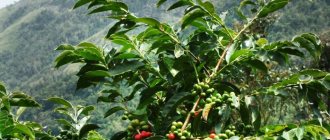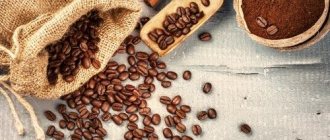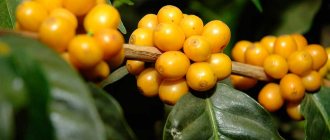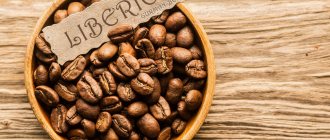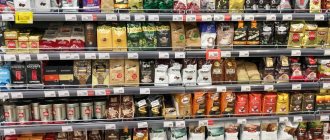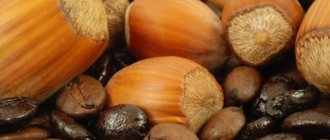For 150 years, Brazil has provided at least 33% of the world's coffee market. Coffee plantations are predominantly located in the southeastern states (Paraná, São Paulo, Esperito Santo, Minas Geras), although overall coffee is grown in 17 of the 21 states. Brazilian coffee plantations cover an area of more than 27,000 km2, on which 6 million trees grow. This distribution of this plant in Brazil is explained by the fact that the mild, sunny and humid climate of this country is most optimal for coffee trees.
History of Brazilian coffee
Now ask any schoolchild what he knows about coffee, and you will get an instant answer: Brazil is the country of coffee. But we will try to dispel doubts about the origin of this plant.
Few people know that the coffee bush was brought to Brazil illegally, through intrigue, love and seduction of women. At the beginning of the eighteenth century, diplomat Francisco de Melo Palheta used all his charm to carry out the order of his government and bring a coffee tree to the territory of his country at all costs, and the governor’s wife could not resist Francisco’s charms, subsequently giving him the coveted bush .
So in Brazil they began to grow coffee for their own needs, and from the mid-eighteenth century the real coffee boom of Brazil began, exporting coffee to America and Europe. People quickly liked the beans, which had invigorating properties, and coffee production in Brazil gained unprecedented momentum. In the mid-twentieth century, Brazilian coffee accounted for almost 40 percent of total world production.
Due to the increase in industrial production volumes, workers were required. People began to migrate from all over the world to provide inexpensive labor, and the beginning of the twentieth century marked the second coffee boom in Brazil. It is known under the slogan Coffee with milk. It was on these two products that the country's economic growth was based.
During this period, the country processed an incredible amount of coffee, the market was oversaturated, the government was forced to increase the price of Brazilian coffee and banned exports to other countries until the price returned to its previous positions.
By 1920, Brazil had become virtually the only coffee-producing country, accounting for eighty percent of the world's coffee industry. But in the early fifties, other countries began to produce coffee no worse than Brazil, and foreign coffee gradually began to displace the main monopolist.
Tastes in coffee have changed, and a softer taste and refined aroma have become valued. Brazilian coffee, produced in huge quantities, began to suffer from competition. Other states demanded that export standards be reduced. Now Latin Americans are investing heavily in coffee production, which allows them not to lose their position and remain a leader in the coffee industry.
Method of growing and processing raw materials
There are no high mountainous regions in Brazil, so coffee grows on plantations, the taste of which is soft and strong. It is generally accepted that the higher the fruits grow, the richer their taste, but despite this opinion, Brazil does not give up its leadership in the production of coffee beans. The advantage of Brazilian coffee is the lack of sourness, which not everyone likes, due to the area where it grows.
In this country, in most cases, the dry harvesting method is used, leaving the grains to dry in the open air for several weeks. Dry grains turn brown. Then the peeling procedure takes place.
Then they are sifted through several sieves of different diameters, distributing the grains by size. A small amount of beans are processed wet, which significantly increases the cost of the finished coffee beans.
Coffee connoisseurs do not particularly appreciate the taste of Brazilian coffee, since there is no zest in it, it is a simple, tasty and strong drink that can simply invigorate, but they do not get much pleasure from the drink.
The main products produced here are Arabica and Robusta. Robusta is ideal for making espresso, the most common and frequently ordered coffee in the world, the export of Robusta supplies one in three cups of the population.
In order to give the coffee different shades, Brazilian coffee beans are mixed with spices. But before you buy a package of coffee, carefully read the ingredients.
It is unlikely that any ordinary coffee lover will be able to distinguish the type of coffee in a drink; only true gourmets can do this, so Brazilian coffee is perfect for an every day morning ritual.
Coffee growing regions in Brazil
Minas Gerais (state)
Brazil's largest state, Minas Gerais, in the southeast of the country, is home to Brazil's highest mountains, providing a favorable altitude for cultivation and almost 50% of the country's coffee is produced there.
Main coffee growing regions:
Sul di Minas (region)
Historically, this region has been home to many coffee producers, and small farms have been worked here for generations. This is probably why there are so many cooperatives in the region and about 30% of the country's coffee is produced here. Despite the predominance of small farms (10 to 100 hectares), it is an industrialized area where mechanized harvesting is common.
Recently, some areas of the region, such as Carmo di Minas, have attracted special attention. In this municipality, located near the small village of Carmo, many producers try to make the most of the soil and climate to produce good coffee.
Altitude: 700-1350 meters Average temperature: ≈22°C Harvest: May-September Varieties and varieties: Catuaí, Mundo Novo, Icatu, Obatã, and Catuaí Rubi Flavor profile: coffee with light lemon notes and fruity aromas.
Cerrado di Minas (region)
Cerrado de Minas became the first coffee producing region in Brazil to receive the status of “Single region” (Cerrado Mineiro), i.e. coffee grown in a specific region of that country.
Cerrado means tropical savanna. Although this word refers to the entire savanna stretching across many states of Brazil, in relation to coffee the word is assigned to the Cerrado region. It is a large region consisting of 55 municipalities located between Alto Paranaiba, Triangulo Mineiro and northwestern Minas Gerais. Coffee began to be grown here relatively recently, and this may be why there are so many large mechanized farms in the region (from 2 to 300 hectares). About 90% of local farms occupy an area of more than 10 hectares.
Altitude: 800-1300 meters Wet summers and mild and dry winters – the region is well suited for specialty coffee production Harvest: May-September Varieties and varieties: Mundo Novo, Catuaí Flavor profile: Higher acidity coffee with medium body and sweetness.
BRAZIL FINE CUP
The taste of Brazilian coffee
The popularity of Brasilia coffee is limitless, but the taste and aroma remain mediocre. It does not represent any sophistication, however, it is perfect for everyday use. Despite the simplicity of taste, Brazilian coffee is extremely popular. It is used to make such a simple, but so often ordered espresso.
The famous Santos coffee is considered the most popular; it is quite good in both taste and smell. This brand is exported to many countries and it is believed that the Santos coffee brand is the best Brazilian coffee. Another type of coffee is Bourbon Santos, which has clove notes in its taste. It is available in instant and grain form.
Instant coffee is made from failed beans that are not suitable for sale as beans. But for lovers of a very quick morning cup of coffee, instant bourbon Santos is in great demand not only all over the world, but also in the Russian Federation.
Geography
Most Brazilian coffee grows in grasslands and non-volcanic soils. The growing altitude varies from 2,000 m to 4,000 m. The country has 14 major coffee regions spread across 7 states. There are approximately 300,000 coffee plantations in 1,950 cities.
With such a diverse geography, coffee from Brazil varies greatly, from traditional to experimental varieties. Farms also differ from each other: these can be small family plantations with an area of less than 10 hectares, or there can be large production units occupying more than 2,000 hectares.
Types and varieties of Brazilian coffee
There are not so many types of coffee around the world, so coffee plantations in Brazil are planted with Arabica and Robusta, which are familiar to us, in a ratio of 80:20. The influence of the first violin of the coffee business is so great that if the harvest decreases, the cost of coffee around the world will increase, despite the yield in other countries.
Kinds
Espresso is mainly made from Brazilian coffee. The types of coffee are affected by the area of cultivation, Arabica varieties, the size and color of the fruit itself, and the parameters of the richness of taste and aroma.
Brazilian coffee, the best varieties
The diversity of Brazilian coffee varieties does not in any way affect the sustainable cultivation of only two types - Brazilian Arabica and Robusta, and the more capricious Arabica is grown by a significant margin more than the primitive Robusta. For Arabica beans, elevated areas with a dry climate are preferred so that the beans are harder.
Coffee beans contain a small amount of caffeine, but they have a unique aroma that robusta is incapable of. Robusta grows in low bushes in low-lying areas of the country, but its beans contain more caffeine, making it ideal for an invigorating morning drink.
Quality control is carried out at every stage of harvesting and processing, right up to packaging. Since Brazil has many competitors, and quite justified ones, Brazilian manufacturers have no right to make mistakes in quality. And every year the quality of products is valued more than quantity.
It is not possible to single out the best type of coffee, since experts have divided their opinions, but we will try to present the line of the most popular varieties as follows.
- Brazil Santos coffee is the most popular variety of Brazilian coffee. It consists of several varieties, combining all the delicacy and delicacy of the drink. In regular sales you can find Santos coffee of the fourth grade. The first grade is more the exception than the rule.
- Maragogyp coffee is a combination variety with large beans.
- Brazil Iponema Rubi - This coffee grows in the highest mountainous areas and is popular in Latin American countries.
- Brazil yellow bourbon is a gourmet find, produced in its pure form.
- Brazil mogiana coffee is a type of specialized variety that has a fine line between sweetness and sourness.
Coffee Santos
This variety ranks first in popularity due to its taste and affordable price. It is a descendant of the old Arabica and grows mainly in the south.
Variety Minas
It has a specific smell due to the soil on which it grows, it is used in blends, it is not considered as a single variety, and it has a tart taste.
Maragogyp
It is distinguished by its large fruit size. Ambiguous expert opinion. But he did not leave anyone indifferent. It has a rather rough taste.
Variety Paransky
In the line of varieties of Parano coffee (and there are seven of them), the fifth is the most sold. This variety is not as high quality as the previous ones, but it is much cheaper. Paransky is named after the name of the port. Many varieties are named after the area in which they are grown, and the Paranan variety is no exception. Brazil even named the coffee brand brazil, after the entire country.
Interesting Facts
- Brazil is not only the largest exporter of coffee in the world, but also one of its main consumers. It is believed that the average resident of the country drinks 5 cups of the drink per day.
- Many countries name the drink not by its origin, but by its method of preparation. For example, the famous Turkish coffee is beans from Brazil, ground, roasted and brewed in Turkey.
- In Brazil, coffee is brewed according to traditional recipes. Locals prefer the drink with milk.
- The country mainly sells beans and ground coffee. Instant drink accounts for just over 10% of production.
- Almost all Brazilian coffee is soft. Sourness is present only in the high-mountain product.
- Coffee plantation workers often work irregular hours. Many do not receive a salary in exchange for the opportunity to live while producing. In a word, they were not far from slavery.
- On private plantations in Brazil, grains are often harvested, cleaned and dried by hand. This gives the product more value.
- World-famous companies like Illy, Danesi, Jardin, Cafes la Brasilena, Minges work with Brazilian suppliers.
- Only in Brazil can the coffee harvest be affected by frost. All other world producers of the drink can boast of a mild climate.
- Before roasting, coffee beans are always green in color. The lighter the roast, the deeper the flavor. If the manufacturer overcooks the grains, the taste will be rough.
It is not necessary to buy Brazilian coffee in the producer's homeland. It is available in almost every country in the world. However, if you go to Rio de Janeiro, Sao Paulo or any other city in Brazil, bring home a couple of packs of beans or ground coffee. You will benefit in price and at the same time appreciate local roasting. Read our large article on shopping for what else you can bring from Brazil.
>>> Useful services for travelers (gift inside!) <<
